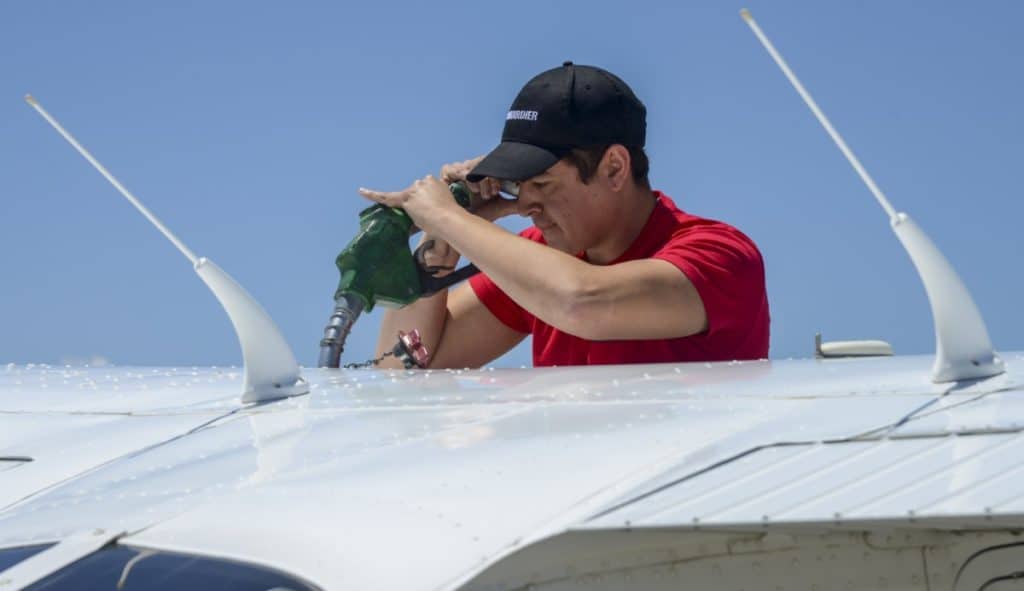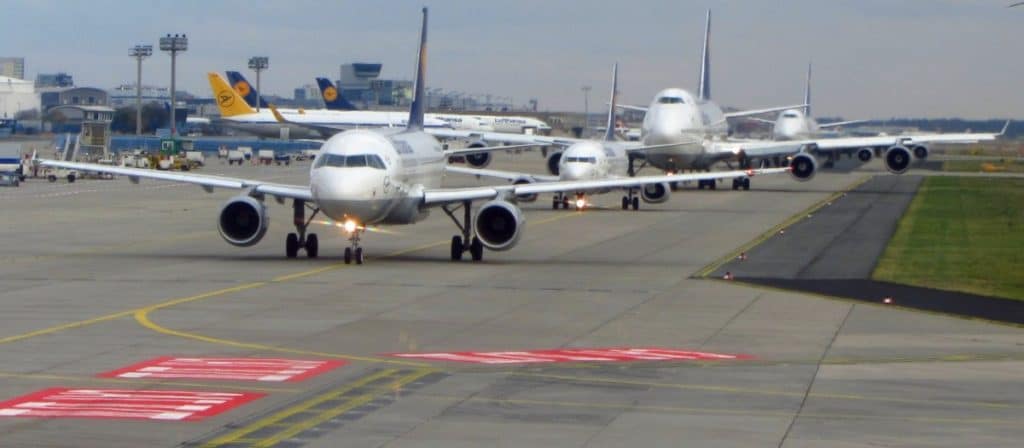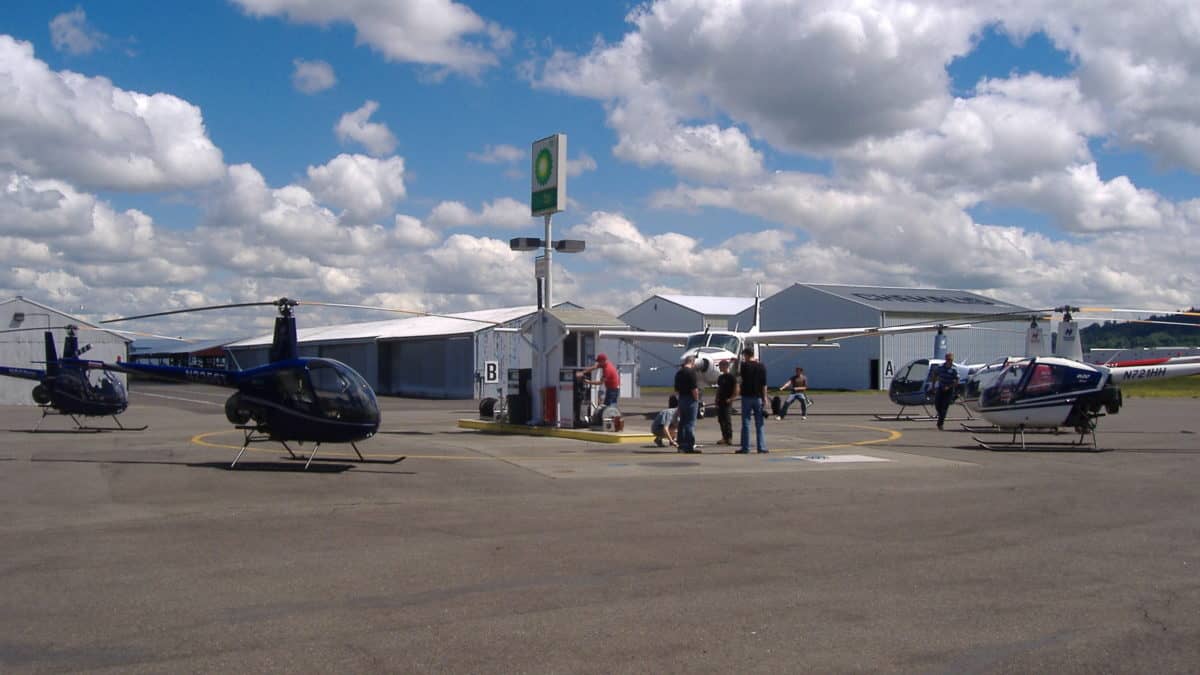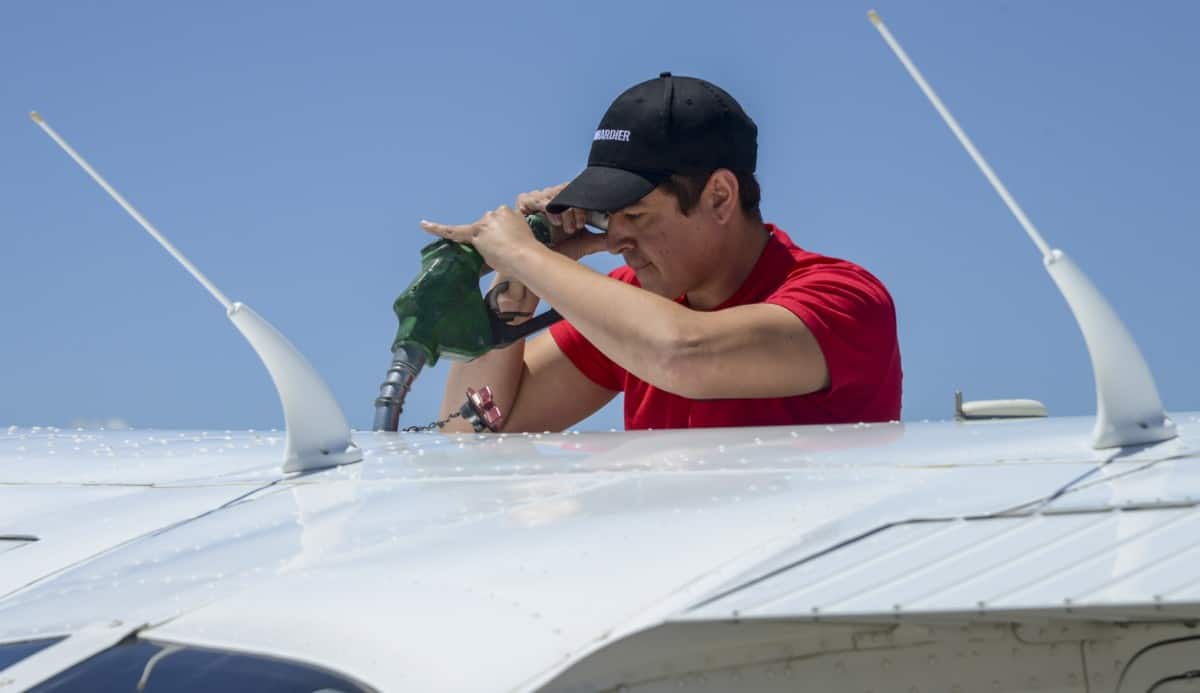
Ensuring there is enough fuel on board to make it to the aircraft’s destination is quite an important part of the flight, especially for everyone on board. Most of us fill up our cars by pulling up to the gas pump and filling up until the tank is full. Is this the same for airplanes and helicopters?
Fuel is calculated based on the fuel consumption of the aircraft vs. the time it takes to get to its destination, plus legally required fuel reserves for diversions and delays. All of the flight time is added together, then multiplied by the hourly fuel consumption to calculate the total amount required.
Fuel planning is quite a simple process but care must be taken to ensure it is completed correctly otherwise the pilots may need to divert to an airport to ‘Top’-up’ or run out of fuel mid-flight if there is no fueling facility within reach!
Being a helicopter pilot I fly in some very remote locations and fuel planning can be one of the most time-consuming parts of planning a flight.
If you wish to know more about how pilots calculate fuel for their flights, no matter which aircraft they are flying, then please read on!
How is Fuel Calculated for Large Airplanes?
Airline pilots have it easy when it comes to calculating their fuel because it has been already done for them! Most large airlines have an entire flight planning department that looks at each flight, its route, forecasted weather, and previous flight data and completes the fuel required calculation for them.
Once the pilots receive their ‘Flight Plan Package’ before the flight they will do a quick check to ensure the planners have not made any mistakes and then give the go-ahead for the aircraft to be refueled at the gate.
To calculate fuel for the flight the planners will feed the following variables into the equation to arrive at the required fuel amount for that particular flight leg:
Taxi Fuel – All fuel required for taxing to and from the runways pre & post-flight. A Boeing 747 can use anywhere from 1000-1500Kg of jet fuel taxiing around a large airport!

Trip Fuel – The fuel estimated to be burned from wheels up to wheels down. The longer the distance between airports, the more fuel will be required.
Contingency Fuel – By law, all aircraft must carry enough fuel reserve to account for unforeseen delays, unforecast weather, or time to deal with an emergency. 5% of the Trip Fuel amount is a typical minimum.
Diversion Fuel – Unroseen destination airport closures due to weather, stricken aircraft on a runway or other events may require approaching aircraft to divert to another airport. Fuel must be taken to account for this.
Final Reserve Fuel – The ‘Stand-by’ fuel. This is to be sued as an absolute last resort in the case of dire unforeseen delays. This is typically 20 minutes of flight in a holding pattern over the destination airport.
Ballast Fuel – Some aircraft may need to keep fuel in certain tanks during the flight to ensure the weight and balance remains within limits. This fuel cannot be burned and this can be quite common in cargo aircraft when flying unusual cargo loads.
Once all of the fuel requirements are known the planners can then begin to complete the calculation:
Taxi Fuel + Trip Fuel + Contingency Fuel + Diversion Fuel + Final Reserve Fuel + Ballast Fuel (if required) = Total Leg Fuel
Aircraft fuel consumption is based on the hourly fuel burn rate of each engine multiplied by the number of engines on the aircraft. An airplane with 4 engines will burn more fuel than an airplane with only 2 of the same engines.
Total Leg Fuel x Total Aircraft Fuel Consumption
For Example:
Boeing 737-800
Total fuel burn is around 750 Gallons/hour
Total Leg Fuel is around 3h45min
3.75 hours x 750 = 2812 gallons of fuel required for the flight leg
Airbus A380
Total fuel burn is around 4,050 Gallons/hour
Total Leg Fuel is around 12h55min
12.90 hours x 4,050 = 52,245 gallons of fuel required for the flight leg
Learn More…
Try These Articles:
* How Long to Refuel an Airplane? – 15 Most Common Planes
* How Much Fuel Do Airplanes Carry? (With 15 Examples)
How is Fuel Calculated for Small Airplanes & Helicopters?
Fuel is calculated by the pilots for flying from departure to destination plus an additional 20 minutes at cruise power. Wind speed & direction, distance, airspeed, and routing are all computed to give the pilot the amount of fuel required for that leg. Fuel stops may be required for flights over a few hours.

Unlike the airlines, pilots of smaller airplanes and helicopters have to complete the flight planning and fuel calculations themselves. This is a major part of learning to become a pilot and all the factors that a pilot needs to consider are taught and learned before they are sent for their flight test.
The major problem with smaller aircraft is they are limited in how much weight they can take when flying. This includes the pilot/s, passengers, baggage or cargo, and finally fuel.
Every aircraft has a Maximum Gross Takeoff Weight and this is basically the maximum weight limit that the aircraft can weigh when it becomes airborne. This limit is set by the aircraft manufacturer is specified to ensure the aircraft remains within its center of gravity limitations, flight control limitations, and aerodynamic load stresses for all parts of the flight.
Because of this lower takeoff weight compared to the large airliners, the pilot must calculate the weight of everything that is required to be flown, and then they are left with how much fuel can be taken. The more weight of passengers and cargo, usually means the less fuel can be carried.

Join My Newsletter & Get Great Tips, Information and Experiences To Help You Become a Superb Pilot!
For Example:
Cessna 172 Skyhawk
Maximum Gross Takeoff Weight = 2,550lbs
Pilot = 180lbs
2 passengers = 185lbs + 220lbs = 305lbs
50lb baggage each = 100lbs
Payload = 180 + 305 + 100 = 585lbs
Maximum Gross Takeoff Weight – Aircraft Empty Weight = 2,550 – 1,700 = 850lbs for Payload & Fuel
850lbs – 585lbs = 300lbs for fuel
AvGas Fuel Weight = 6lbs per gallon
Fuel consumption = 8.5 gallons per hour or 8.5 x 6 = 51lbs per hour
300lbs/51lbs = 5h50min hours of flight time available
As you can see the Cessna 172 is a great little aircraft that can carry a good amount of payload and still have lots of room for fuel, but the weight and fuel calculations have to be completed in tandem to ensure they both work together.
Learn More…
Try These Articles:
* What Fuel Do Aircraft Use? – Same As Your Car???
* How Much Fuel Does a Helicopter Use? Get Your Credit Card Out!
If for example, the pilot could only take 3 hours of fuel but the destination was 3.5 hours flight away, they would have to find an airport along the proposed flight route, check to see if has the right kind of fuel, and ensure there is either someone there to pump it, or it has a credit card fuel pump so the pilot can pump their own fuel, just like you would your own car.
If there is no airport along the route to stop and get fuel then the pilot will have to see about offloading weight to be able to take more fuel or plan a different routing to ensure they can fill up at another airport on the way.


